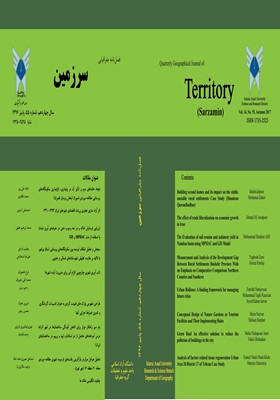تاب آوری شهری چارچوبی الزام آور برای مدیریت آینده شهرها
محورهای موضوعی : جغرافیا و برنامه ریزی شهریفرخ نامجویان 1 , محمد تقی رضویان 2 , رحیم سرور 3
1 - سازمان پیشگیری و مدیریت بحران شهر تهران
مدیر ارزیابی عملکرد
2 - استاد دانشگاه شهید بهشتی
3 - استاد دانشگاه آزاد اسلامی واحد علوم و تحقیقات تهران
کلید واژه: مدیریت آینده شهر, بازیابی شهری, تابآوری شهری, آسیب پذیری,
چکیده مقاله :
همزمان با بزرگتر شدن شهرها و تنوع نیاز های شهری، در کنار آسیبها و تهدیدهای طبیعی مسائل انسانی نیز شهرها را تهدیدخواهندکرد.بنابراین لازمست تا به دنبال افزایش ظرفیت و توان سکونتگاههای شهری و ضریب تابآوری آنها، زمینه برای مدیریت با کیفیت شهرها برای نسلهای آینده مهیا گردد. این پژوهش با هدف بررسی و تبیین دیدگاهها و مدلهای تابآوری شهری به دنبال تدوین چارچوبی مناسب برای مدیریت آینده شهرها صورت گرفته است. نتایج حاکی از آن است که ، به دلیل گستردگی مفهوم تابآوری در همه ابعاد اجتماعی، اقتصادی، نهادی- برنامه ریزی و نیز کالبدی-زیرساختی، مدیران شهری باید به تحلیل لایههای شهری در ابعاد مختلف، بهبود سطح خدمات در زمان بحران، شناخت اماکن آسیب-پذیر در زمان بحران، تقلیل میزان خطر با افزایش استحکام و برنامه ریزی زیر ساخت ها و بهره گیری از مدلهای بازیابی در کوتاهترین زمان ممکن پرداخته و با عنایت به این متغیرها و مولفهها میتوان شهرهای آینده را تابآور نمود.
As cities become larger and the diversity of urban needs, along with natural hazards and threats, humanitarian issues threaten cities as well. Therefore, it is necessary to seek to increase the capacity and capacity of urban settlements and their resilience coefficient, the field for management with The quality of cities will be provided for generations to come. The purpose of this study was to investigate and explain the perspectives and models of urban viability following the development of an appropriate framework for managing the future of cities. The results indicate that, due to the wide scope of the concept of vibration in all dimensions of social, economic, institutional and planning, as well as physical-infrastructure, urban managers should analyze urban layers in different dimensions, improve the level of services during the crisis. , Identifying vulnerable places in times of crisis, reducing the risk by increasing the strength and planning of infrastructure and utilizing recovery models in the shortest possible time, and considering these variables and components, future cities Waved.
_||_

